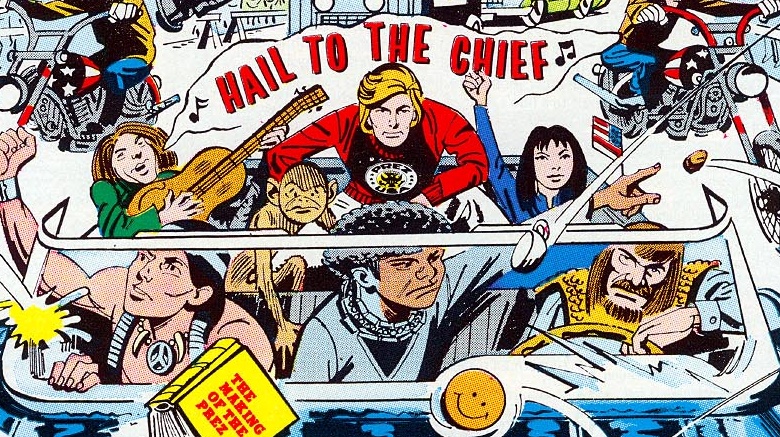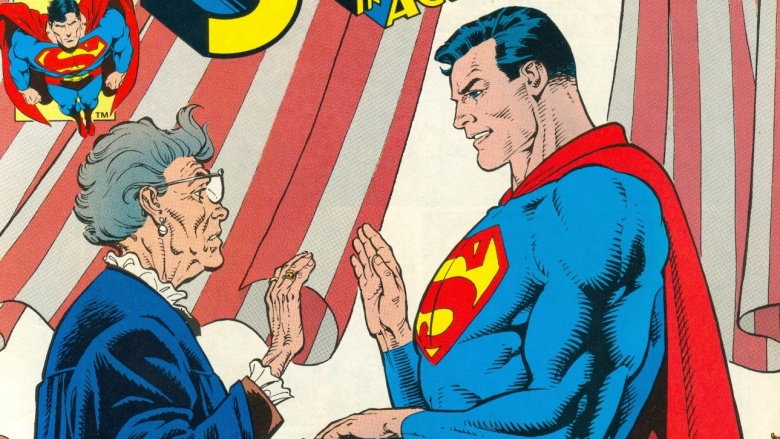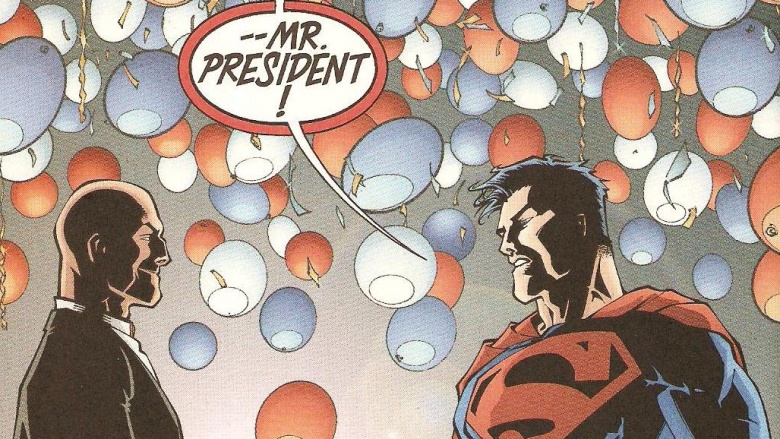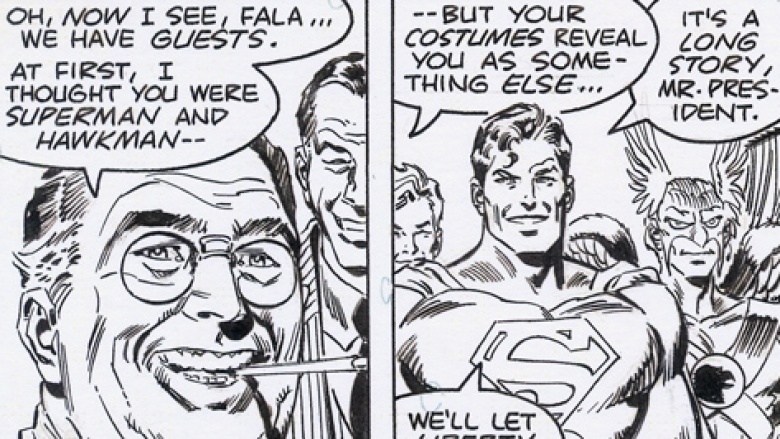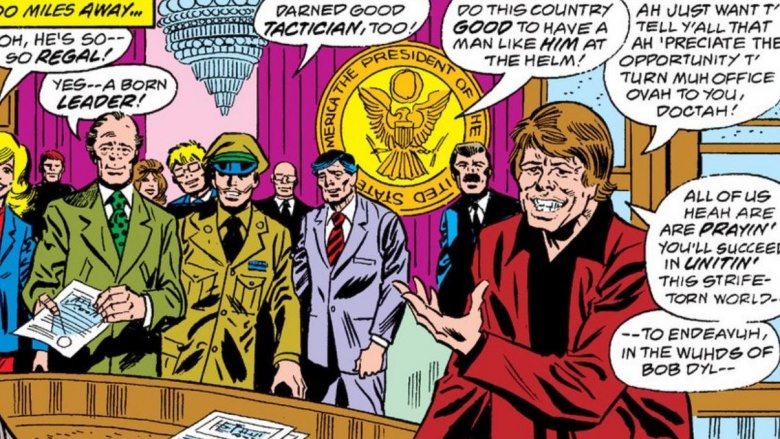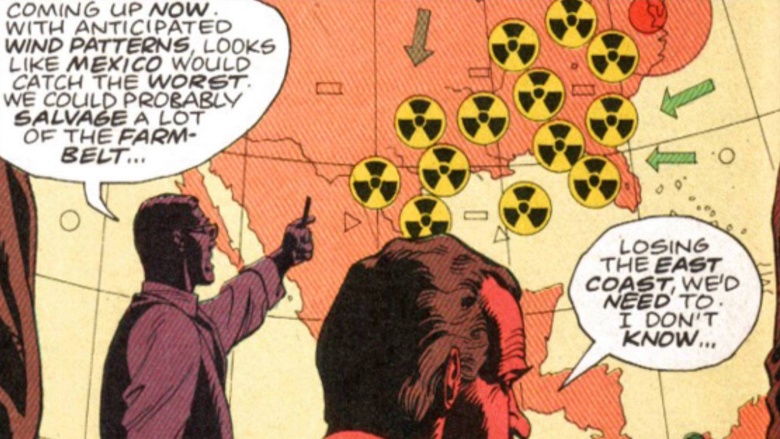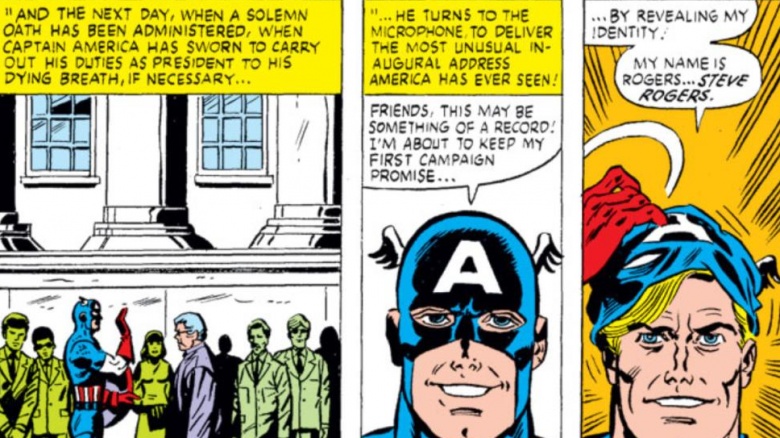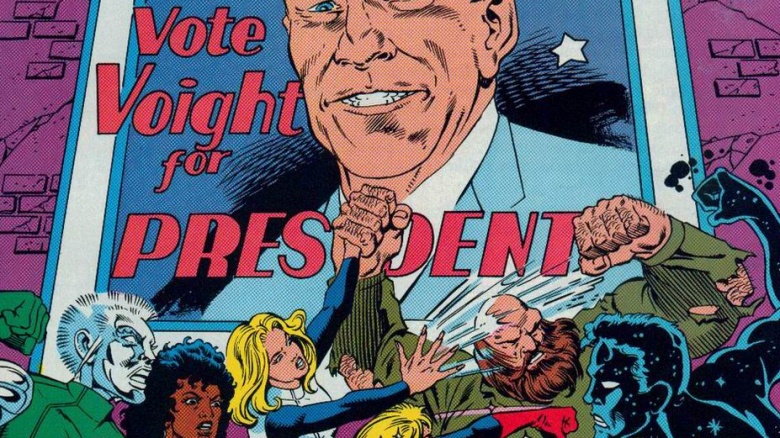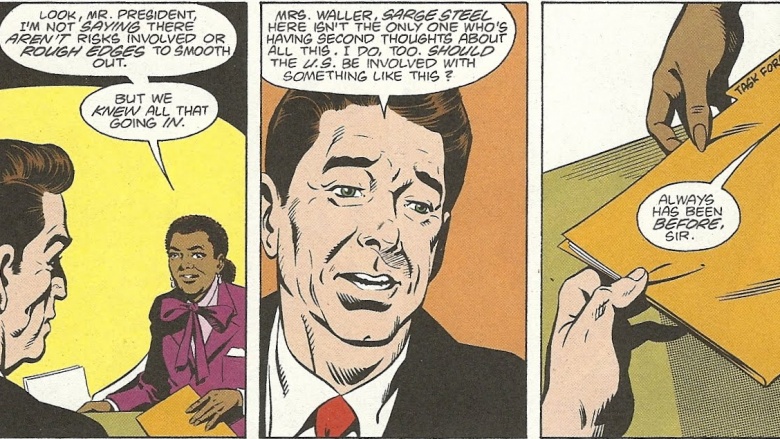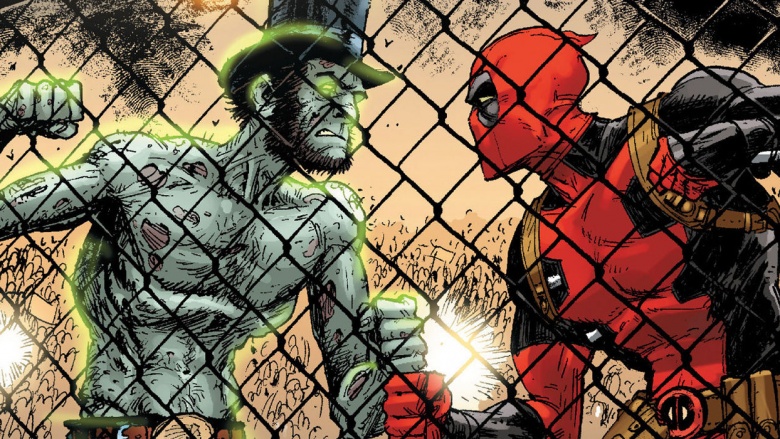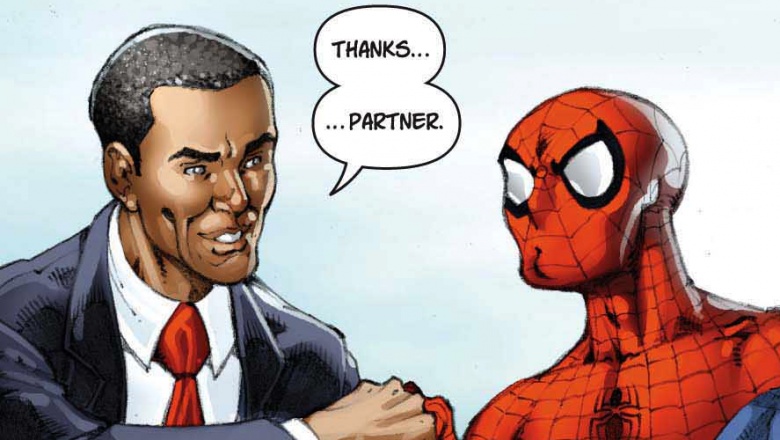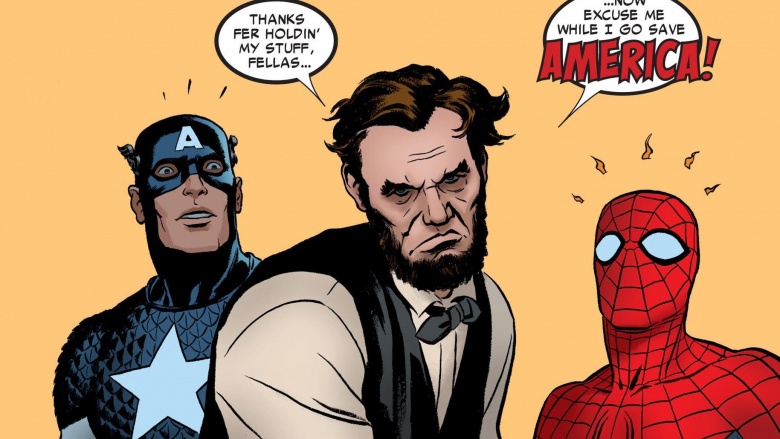The Most Bizarre Presidential Moments In Comic Book History
We haven't quite reached the point—yet—where the actual goings-on in the Oval Office can match the strange stuff that's come up in comic books. But the two worlds collide more often than you might think, and with that in mind, we've taken a look back at some of the strangest and most jaw-dropping moments that have linked the White House and the panels of your favorite comics.
Prez: First Teen President
What better way to kick things off than with one of the most bizarre premises for a comic book ever attempted by a major publisher? In 1973, DC Comics made an ill-conceived effort to speak directly to the hip, happening youngsters who purchased their funny books by delivering unto them Prez: First Teen President. How, you ask, did a teenager end up as the leader of the free world? As the comic explains, Prez Rickard—that's the Commander in Chief's name, don't wear it out—was elected as a United States Senator, after which Congress lowered the eligibility age for the presidency to 18 in order to cater to the large percentage of voters under 30, and the rest is history.
As it happens, Prez itself was history after all of four issues, but that was still plenty enough time for the book to make an impression: since then, Neil Gaiman spotlighted him in Sandman, Ed Brubaker wrote a Vertigo Comics one-shot entitled Prez: Smells Like Teen President, Frank Miller leaned heavily on the character in The Dark Knight Strikes Again to create a computer-program president named Rick Rickard, and in 2015 DC kicked off a new 12-issue Prez series, this time focusing on a teenage girl who gets elected president through Twitter.
President Superman
In the early 1990s, DC Comics had a plotline running concurrently throughout virtually all of their titles: "Armageddon 2001," which revolved around a villainous tyrant named Monarch who was destined to take over the world...unless, that is, someone from the future could stop him from ever coming to power. Enter Matthew Ryder, a.k.a. Waverider, who travelled from 2001 back to 1991 and tried to stop the man who would become Monarch from turning evil and beginning his plans of global domination.
Unfortunately, without knowing Monarch's true identity, Waverider had to make brief physical contact with various key figures in the superhero community in order to see glimpses of their futures. When he touched Superman, he saw a future wherein a series of events results in Superman's secret identity being exposed while Clark Kent is helping with Pete Ross's presidential campaign, leading to Ross asking his old friend to take over his presidential run. Yes, we know, Superman shouldn't theoretically be eligible for the presidency, given that he was born way, way outside of the United States, but he had a really good lawyer: the Supreme Court voted in agreement that Superman was conceived in the Kryptonian birthing matrix, and thus wasn't actually "born" until the matrix opened upon the Kents finding it. (Damn, that guy's good.)
President Lex Luthor
We know what you're thinking: how does a guy who's known far and wide as being Superman's nemesis and one of the most despicable supervillains of all time end up getting elected President of the United States? As Chris Sims explained at Comics Alliance, you can more or less blame the Luthor presidency on the state of comic books at the time and the fact that publishers needed "events" in their comics if they were going to keep readers coming back—and after DC's Crisis on Infinite Earths, Luthor had been rebooted as more of a evil businessman than an evil genius, making it somewhat less of a stretch to conceive of the guy ending up in the White House.
FDR takes part in a JLA / JSA / All-Star Squadron team-up
From the 1960s through the 1980s, one of the most enjoyable traditions carried on by DC Comics was the annual crossover between the Justice League of America on Earth-1 and the Justice Society of America on Earth-2, with half of the fun being derived from how the JLA writers would up the ante from year to year. Over the course of the various crossovers, the JLA and the JSA found themselves working with the Freedom Fighters, the Seven Soldiers of Victory, the Legion of Super-Heroes, the New Gods, the heroes of Earth-S (home to the Shazam! family and their ilk, don't you know), and a variety of time-tossed heroes ranging from the Viking Prince to Jonah Hex.
The last big JLA-JSA throwdown, however, spanned time and space (not to mention Justice League of America #207-209 and All-Star Squadron #14-15), taking them to a variety of worlds and eras, the most notable involving a trip to Earth-2 during World War II, where members of the JLA and the JSA from the present teamed up with Earth-2's premier wartime supergroup, the All-Star Squadron. (We don't use an acronym for that one, for reasons which will become clear as soon as you try it yourself.) During the course of their trip, the heroes found their way to the White House, where they met President Franklin Delano Roosevelt. As befits a man with his reputation, FDR didn't so much as blink an eye when presented with heroes from another world and another time.
Jimmy Carter tries to quote Dylan lyrics to Dr. Doom
This is really just a throwaway joke in a single panel of the short-lived '70s series Super Villain Team Up, but it's so absolutely goofy that it warrants mention. As for the plot, all you really need to know is that Dr. Doom has used chemical means to hypnotically control virtually everyone on the planet, and as a result, he's able to convince the U.S. government to hand him the presidency. In turn, President Carter—who at the time was famous for being down with what the kids were listening to—offered his support to President Doom by way of trying to quote Bob Dylan, and...well, you probably don't need to see the next panel to know that Doom really isn't much of a Dylan fan.
Dick Nixon kicks America around for several more years
There's a lot going on in Alan Moore's Watchmen, so much so that you can't really absorb it all without reading it a few times, but one thing that really stands out—particularly in the movie adaptation, but it's pretty obvious in the comic, too—is that Richard Nixon is still president. We don't really get an explanation as to how that came to pass and when the 22nd Amendment was repealed, but it clearly happened.
President Captain America
To celebrate Captain America's 250th issue in 1980, its writers composed an issue revolving around the concept of Cap running for president and whether or not it would prove to be a viable idea, since he truly is the embodiment of America in superhero form. Ultimately, Cap concedes that, although the American people might trust him, he doesn't have the experience and, more importantly, his goal has always been to preserve the American Dream, which would go against the needs of the presidency. It was too good an idea just to abandon, however, so the following year Marvel ran an issue of What If? where Cap did run for president and win. Oh, and he also died, so he probably made the right decision in not running.
Mr. Voigt Goes to Washington
Marvel Comics' "New Universe" was an interesting idea—they literally created an all-new universe that had nothing to do with the existing Marvel Universe and tried to make it just as big a deal as the original—but it ended up fizzling out far sooner than fans might've liked. Still, even those few years were enough time for the characters of D.P. 7 (the "D.P." stands for "Displaced Paranormals") to escape from the clutches of Philip Nolan Voigt, director of the Clinic for Paranormal Research, only for him to successfully run for President of the United States. That's a heck of a bump in status over the course of 32 issues.
Ronald Reagan reboots the Suicide Squad
The Suicide Squad has floated through the DC Universe since the 1950s, but back then it was just a team of adventurers with no fear. In the 1980s, however, DC rebooted the concept to make it about a covert task force of supervillains given assignments to complete on behalf of the government, with the understanding that if they survive, they're freed. In the miniseries Legends, Amanda Waller convinces President Reagan to sign off on the idea, so you can blame it on Ronnie.
Deadpool vs. Zombie Presidents
When it comes to reading Deadpool, there's really only one rule to keep in mind: sit back, don't ask questions, and enjoy the ride. As such, we're not even going to try and relate the plot of this storyline, except to say that Deadpool ends up battling the reanimated corpses of just about every dead president in U.S. history. Needless to say, it's a must-read.
Obama - Spider-Man Team-Up
Given how prominent President Barack Obama is on the cover of The Amazing Spider-Man #583, you might be surprised to learn that "Spidey Meets the President!" was actually only the issue's backup story. Still, who's going to complain about an opportunity to see Obama vs. the Chameleon?
Captain America. Spider-Man. Abraham Lincoln. 'Nuff said
In a one-shot comic put together by Marvel to celebrate Presidents Day 2009, Captain America and Spider-Man somehow find their way through the mists of time and assist President Lincoln in a story entitled—wait for it—"Gettysburg Distress." Be honest: do you even need to know anything else? It doesn't get any better than that.

